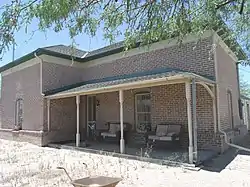Harvey-Niemeyer House
The Harvey-Niemeyer House, in Florence, Arizona, is a one-story house built around 1874. It was listed on the National Register of Historic Places in 1986,[1] as a result of a study of historic resources in the Florence area.[2]
Harvey-Niemeyer House | |
 | |
 | |
| Location | 250 S. Main St., Florence, Arizona |
|---|---|
| Coordinates | 33.029167°N 111.386944°W |
| Area | less than one acre |
| Built | 1875 |
| Architectural style | Queen Anne, Sonoran |
| MPS | Florence MRA |
| NRHP reference No. | 86002627[1] |
| Added to NRHP | August 1, 1986 |
It was built first as a "T"-shaped adobe house, which was probably flat-roofed, with an attached front porch and a rear frame addition, around 1874. It was renovated in 1892 with addition of a hipped roof and a veneer of fired brick on all but the rear facade. It was expanded also with a row of rooms across its rear in 1936.[3]
It was deemed significant as "an outstanding example of a local architectural type known as 'Early Transitional.' Early Transitional buildings manifest characteristics of both Sonoran and American Victorian styles. The building is also associated with two locally significant individuals: Dr. William Harvey, M.D., and Charles H. Niemeyer." It was judged to be comparable to the best examples of Early Transitional style in the National Register-listed Florence Townsite Historic District.[3]
It is located outside that district at 250 S. Main St., but when it was listed its address was 1618 Main St.[note 1]
It is a one-story house built of adobe around 1874. It was remodeled in 1892 and expanded in 1936. It is about 42 by 45 feet (13 m × 14 m) in plan.[3]
It was home of physician William Harvey, who became known as an "Angel of Mercy" during a smallpox epidemic. Harvey also came to address the aftermath of the 1888 Gabriel-Phy shootout. Charles Niemeyer, a later homeowner, served as a postmaster and, for 25 years, as Clerk of the Pinal County Board of Supervisors.[4]
Notes
- There is building code requiring numbering South and North to commence at a certain street, suggesting that the city implemented a renumbering of locations on this and other streets. The codes also requires posting of street numbers. See here.
References
- "National Register Information System". National Register of Historic Places. National Park Service. November 2, 2013.
- Reba N. Wells; Andrea Urbas (October 1, 1985). "National Register of Historic Places Inventory-Nomination: Florence Multiple Resource Area". National Archives.
- Billy G. Garrett, 1984 (1984). "Florence MRA – Site Number 11 – Harvey/Niemeyer House: Supplemental Information". National Park Service. Retrieved November 20, 2021. With accompanying photo from 1985, and Arizona State Historic Property Inventory of 1985
- "Arizona Century: 1880 – Harvey-Niemeyer House".